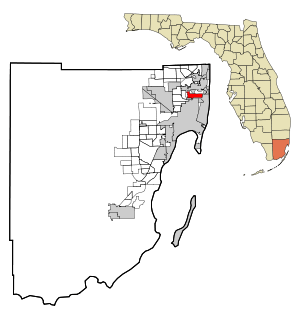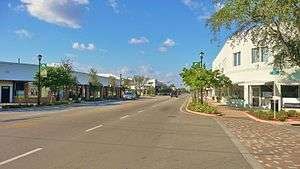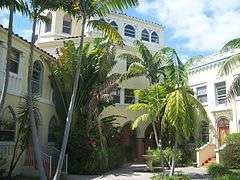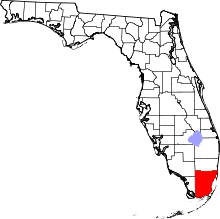Miami Shores, Florida
| Miami Shores, Florida | ||
|---|---|---|
| Village | ||
|
Downtown Miami Shores | ||
| ||
| Nickname(s): The Shores | ||
| Motto: Viventes In Sole | ||
 Location in Miami-Dade County and the state of Florida | ||
 U.S. Census Bureau map showing village boundaries | ||
| Coordinates: 25°51′54.86″N 80°11′18″W / 25.8652389°N 80.18833°WCoordinates: 25°51′54.86″N 80°11′18″W / 25.8652389°N 80.18833°W | ||
| Country |
| |
| State |
| |
| County |
| |
| Incorporated | January 2, 1932 | |
| Government | ||
| • Type | Council-Manager | |
| • Mayor | Alice Burch | |
| • Vice Mayor | Steven Zelkowitz | |
| • Councilmembers | Herta Holly, Jesse Walters, and Ivonne Ledesma | |
| • Village Manager | Tom Benton | |
| • Village Clerk | Barbara A. Estep | |
| Area | ||
| • Village | 3.7 sq mi (9.7 km2) | |
| • Land | 2.5 sq mi (6.4 km2) | |
| • Water | 1.3 sq mi (3.3 km2) 34.05% | |
| Elevation | 7 ft (2 m) | |
| Population (2010) | ||
| • Village | 10,493 | |
| • Density | 4,191.9/sq mi (1,618.5/km2) | |
| • Metro | 5,422,200 | |
| Time zone | EST (UTC-5) | |
| • Summer (DST) | EDT (UTC-4) | |
| Zip Codes | 33138, 33150, 33153, 33161, 33167, 33168 | |
| Area code(s) | 305, 786 | |
| FIPS code | 12-45175[1] | |
| GNIS feature ID | 0286760[2] | |
| Website | http://www.miamishoresvillage.com/ | |
Miami Shores is a village in Miami-Dade County, Florida, United States.
History
Miami Shores was originally a neighborhood of the City of Miami when it was annexed into the city of Miami in 1925. With the arrival of the Great Depression, the City of Miami gave up its jurisdiction and Miami Shores was incorporated as its own village in 1932.
Geography
Miami Shores is located at 25°51′55″N 80°11′18″W / 25.865240°N 80.188451°W.[3]
According to the United States Census Bureau, the village has a total area of 9.7 km2 (3.75 sq mi). 6.4 square kilometres (2.47 sq mi) of it is land and 3.3 square kilometres (1.3 sq mi) of it (34.05%) is water.
Demographics
| Historical population | |||
|---|---|---|---|
| Census | Pop. | %± | |
| 1930 | 612 | — | |
| 1940 | 1,956 | 219.6% | |
| 1950 | 5,086 | 160.0% | |
| 1960 | 8,865 | 74.3% | |
| 1970 | 9,425 | 6.3% | |
| 1980 | 9,244 | −1.9% | |
| 1990 | 10,084 | 9.1% | |
| 2000 | 10,380 | 2.9% | |
| 2010 | 10,493 | 1.1% | |
| Est. 2015 | 10,831 | [4] | 3.2% |
| Miami Shores Demographics | |||
|---|---|---|---|
| 2010 Census | Miami Shores | Miami-Dade County | Florida |
| Total population | 10,493 | 2,496,435 | 18,801,310 |
| Population, percent change, 2000 to 2010 | +1.1% | +10.8% | +17.6% |
| Population density | 4,191.9/sq mi | 1,315.5/sq mi | 350.6/sq mi |
| White or Caucasian (including White Hispanic) | 49.1% | 73.8% | 75.0% |
| (Non-Hispanic White or Caucasian) | 42.1% | 15.4% | 57.9% |
| Black or African-American | 23.8% | 18.9% | 16.0% |
| Hispanic or Latino (of any race) | 30.6% | 65.0% | 22.5% |
| Asian | 2.6% | 1.5% | 2.4% |
| Native American or Native Alaskan | 0.3% | 0.2% | 0.4% |
| Some Other Race | 2.3% | 3.2% | 3.6% |
As of 2010, there were 3,935 households out of which 7.8% were vacant. In 2000, 32.1% had children under the age of 18 living with them, 51.0% were married couples living together, 12.1% had a female householder with no husband present, and 33.0% were non-families. 23.4% of all households were made up of individuals and 9.8% had someone living alone who was 65 years of age or older. The average household size was 2.67 and the average family size was 3.24. The village also has one of the highest percentages of homosexual couples in the United States.
In 2000, the village population was spread out with 22.5% under the age of 18, 12.1% from 18 to 24, 28.9% from 25 to 44, 24.0% from 45 to 64, and 12.6% who were 65 years of age or older. The median age was 38 years. For every 100 females there were 95.1 males. For every 100 females age 18 and over, there were 91.7 males.
In 2000, the median income for a household in the village was $56,306, and the median income for a family was $64,963. Males had a median income of $42,373 versus $35,530 for females. The per capita income for the village was $26,134. About 6.9% of families and 8.8% of the population were below the poverty line, including 11.2% of those under age 18 and 7.6% of those age 65 or over.
As of 2000, Miami Shores had the 102nd highest percentage of Colombian residents in the US, with 1.64% of the US populace.[6] It had the fifty-ninth highest percentage of Cuban residents in the US, at 6.27% of the village's population,[7] and the 121st highest percentage of Dominican residents in the US, at 1.28% of its population.[8] It also had the twentieth most Haitians in the US, at 8.30% of all residents.[9]
Based on 2010 data, the ancestries of only the Hispanic and Latino population from highest to lowest were as follows: Cubans made up the 33.41%, South Americans were at 25.97%, Puerto Ricans accounted for 11.48%, Central Americans totaled 10.70%, and Mexicans were 2.95% of all residents.[10]
Government
The village operates under a council-manager system. It has an elected council of five members. The Council members are elected to at-large seats throughout the Village. The Village Charter stipulates that the two individuals receiving the highest number of votes are elected to four year terms. The individual(s) receiving the next highest number of votes is elected to a two-year term. The position of Mayor is selected by the Council at its inaugural meeting. Historically, the individual receiving the highest number of votes is selected to serve as the Mayor, and holds this position for two years of the four-year term. At the conclusion of their term as Mayor, the individual retains a seat on the Council as a "regular" Council member for the next two years. Each Council Member is a voting member of the Council, with the Mayor serving as the Chair.
The council is responsible for enacting most village laws, approving capital expenditures, and hiring the Village Manager. The Village Manager is in charge of managing the day-to-day functions of the village.
Other administrative boards include Planning & Zoning, Recreation Advisory, Historic Preservation, Code Enforcement, and Personnel Appeals. The village is served by the Miami Shores Police Department, and fire services are supplied by Miami-Dade Fire Rescue Department Station 38.
Policy on vegetable gardens
In 2013, the Miami Shores Village Council passed a comprehensive rewrite of its Code of Ordinances. One provision of the rewritten code clarified that vegetable gardens are permitted in backyards but not front yards. Two residents, Hermine Ricketts and Tom Carroll, were forced to remove a garden that had been in place for 17 years or face a fine of $50 a day. The couple claimed that the garden supplied about 80% of their meals and had eliminated their need to buy produce. The Institute for Justice has filed a suit on their behalf, claiming that the ordinance violates their rights under the Florida Constitution.[11][12] The story garnered national attention.
Racial discrimination by law enforcement
Following the ACLU January 2016 report on police using seat belt laws to pull over black drivers nationwide, local CBS-affiliate station WFOR-TV gathered numbers from Florida's department of Highway Safety. They reported that Miami Shores police wrote 261 seat belt citations in 2014, with 186 of those citations going to African American drivers.[13]
Educational institutions
Miami-Dade County Public Schools operates district public schools serving Miami Shores:
MDCPS schools[14]
- Miami Shores Elementary School
- Horace Mann Middle School
- Miami Edison High School
- Miami Country Day School
- Miami Shores Presbyterian Church School
- Miami Shores Baptist Church Academy
- St. Rose of Lima Catholic School
Colleges and universities
Miami Dade College serves as the community college of area residents.
Public library
Miami Shores' public library was founded in 1949.[15] While over the years the county wide Miami-Dade Public Library System has taken over the libraries of most of the cities in the county, the Miami Shores public library has remained independent. This independent public library first opened in February 1949 due to the generosity of George A. Brockway, an industrialist and part-time South Florida resident, who donated the funds to build the library. The land the library was built on was donated by Bessemer Properties under the management of Roy H. Hawkins. This library is considered the central cultural and educational hub of the Village of Miami Shores. Brockway Memorial Library offers patrons a large and diverse collection of materials that contain, print books, magazines, newspapers, online databases, eBooks, multi- media resources such as computers, DVDs, music and a diversity of social clubs and activities to serve the patrons and the community at large.[16] In 2002 funds were raise to be able to construct and additional 2500 square feet to the library. “This new addition was a multimedia room housing, electronic books, dedicated spaces for videos and audio books, reference materials, a Computer Center and the Miami Shores Archives.” The Miami Shores Archives is a special collection of local area history. The library’s schedule is available online.[17]
See also
- Miami Shores Thematic Resource
- National Register of Historic Places listings in Miami-Dade County, Florida
Gallery
References
- ↑ "American FactFinder". United States Census Bureau. Retrieved 2008-01-31.
- ↑ "US Board on Geographic Names". United States Geological Survey. 2007-10-25. Retrieved 2008-01-31.
- ↑ "US Gazetteer files: 2010, 2000, and 1990". United States Census Bureau. 2011-02-12. Retrieved 2011-04-23.
- ↑ "Annual Estimates of the Resident Population for Incorporated Places: April 1, 2010 to July 1, 2015". Retrieved July 2, 2016.
- ↑ "Census of Population and Housing". Census.gov. Retrieved June 4, 2015.
- ↑ "Ancestry Map of Colombian Communities". Epodunk.com. Retrieved 2007-10-29.
- ↑ "Ancestry Map of Cuban Communities". Epodunk.com. Retrieved 2007-10-29.
- ↑ "Ancestry Map of Dominican Communities". Epodunk.com. Retrieved 2007-10-29.
- ↑ "Ancestry Map of Haitian Communities". Epodunk.com. Retrieved 2007-10-29.
- ↑ "Florida City, FL Population and Races". usatoday.com. Retrieved 2015-01-16.
- ↑ Life, liberty and the pursuit of vegetables, Miami Herald, Nov. 19, 2013.
- ↑ Miami Shores Sues Village Over Veggies, CBS Miami, Nov. 19, 2013.
- ↑ ACLU: Blacks Ticketed For Seat Belts Twice Rate Of Whites In Florida CBS4 January 26, 2016
- 1 2 3 "Resident Information Mar 2016.pdf New Resident Information Brochure." Village of Miami Shores. p. 2/4. Retrieved on June 27, 2016.
- ↑ "The Brockway Library Story". Miamishoresvillage.com. Retrieved 2016-03-21.
- ↑ "The Brockway Library Story". Miamishoresvillage.com. Retrieved 2016-03-21.
- ↑ Christensen, Karen; Levinson, David (eds.). Heart of the community: Libraries We Love. Berkshire Publishing Group. pp. 50–51.
| Wikimedia Commons has media related to National Register of Historic Places in Miami Shores, Florida. |





